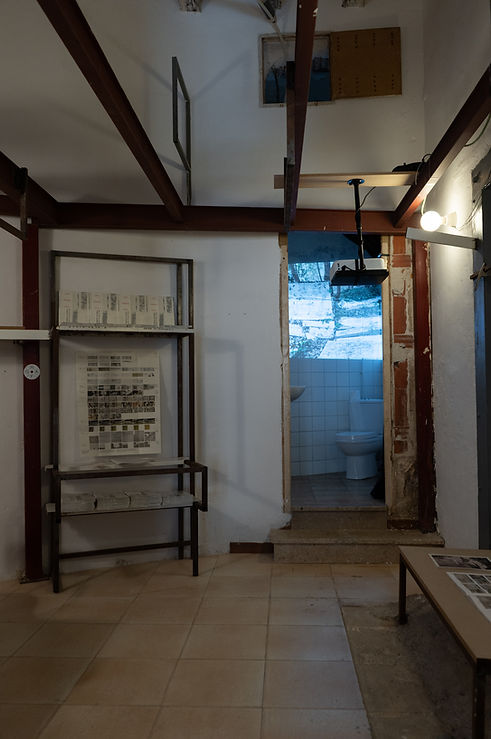LA PRENYADA

A.
broken travertine slab from the Mies van der Rohe Pavilion (109x109x5.5 cm), inoculated with moss and supported on aluminum profiles
lithographs with discarded papers (variable sizes)
latex tube, dechlorinated water, sprayer and protective plastic sheet
-
B.
moss dietary
collection of work by MEATS Elisava students (Inviting Life project), print on paper and HD video 1920x1080

broken travertine slab from the Mies van der Rohe Pavilion (109x109x5.5 cm), inoculated with moss and supported on aluminum profiles
latex tube, dechlorinated water, sprayer and protective plastic sheet
lithographs with discarded papers (variable sizes)




If you go to the Mies van der Rohe Pavilion, at the foot of Montjuïc, early in the morning, you’ll see it breathing. The porous travertine stone draws in moisture from the air overnight, and as the rising sun begins to heat its surface, the dew evaporates into a mist of water vapour, a long exhale following the slow nocturnal inhalation. The stone, and with it the entire building, becomes a living organism. A great Welsh musician sings that ‘rocks are slow life’; we take that statement not as metaphor, but as a political stance. Stone (and architecture) is a form of slow life, and that viewpoint gives rise to new ways of understanding and exercising our relationship with the built environment, whether through human or natural action—the pigeons don’t differentiate between the cliffside of Montjuïc and a street in the Eixample. The travertine of the pavilion is permeated by life in different ways: it is the sedimentary product of a bio-geological process influenced by water; it replicates the process of its formation through saturation and drying in the short daily cycle made visible by its morning exhalation; and it acts as the support for other types of life that grow and develop in the moisture of its pores—bacteria, algae and moss, key agents in the travertine’s own formation. The stone is simultaneously a product of and a support for life.




‘Pregnancy’ is founded precisely on this assumption. The drawings on display in the first gallery space demonstrate the slow, prolonged efforts towards understanding a single fragment of travertine using the hydrophilic technique of lithography.
The slab receives ongoing care from the artists, gallery owners and visitors, who moisten the stone with water each day and protect it at night. The tools used in this care occupy the third area of the room, dominated by a latex tube, which, like an umbilical cord, feeds the travertine slab, connecting it irrevocably to the place—before the ‘Pregnancy’ occurred, bacteria, algae and mosses were already present in the exhibition space in the form of microbial cysts and aerial spores.


Beyond the exhibition space itself, in an area that is usually private, the exhibition continues with a large diary that is updated periodically, mapping the evolution of the moss and other living beings that transform and enrich the travertine slab. This ongoing diary is accompanied by the working documents produced by the students of MEATS Elisava. The final element, in the WC at the far end, is a video projection that explains the working process and the results of the temporary intervention in the Lilly Reich pavilion.

The lithographs, stone, water, care and documentation form a loose ensemble, vaguely articulated throughout the gallery space from the entrance door to the tiled wall of the WC. ‘Pregnancy’ is an installation that aims to reveal the life inherent in matter, and to offer it a further invitation. Not as a metaphor, but as a political action.
Photos:@olave


moss dietary
collection of work by MEATS Elisava students (Inviting Life project), print on paper and HD video 1920x1080 (video@francescamoroni)
